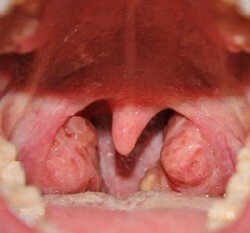 Angina is an infectious disease, the main manifestation of which is inflammation of the tonsils. The disease is provoked by various microbes, mainly streptococci, they fall into the pharynx more often with household items, which used a sore throat.
Angina is an infectious disease, the main manifestation of which is inflammation of the tonsils. The disease is provoked by various microbes, mainly streptococci, they fall into the pharynx more often with household items, which used a sore throat.
The term "angina" has been known since the time of ancient medicine, up to the present time many pathological changes of the oropharynx, having common symptoms, but differing in etiology and course, are associated with it. Often, with any pain in the throat, patients make their own diagnosis and are most often called angina, not seeking to understand the true diagnosis.
According to the conventional classification, the ailment is divided into three types: primary, secondary and specific angina. They have a pronounced seasonal character: the incidence peaks occur during the cold season and periods when the humidity of the air is increased.
The disease is dangerous, because it can lead to serious pathological processes in the heart, kidneys and other organs, so it is very important to treat it in time. The risk group for angina includes children and people with various diseases of the oral cavity and nose - caries, periodontitis, sinusitis, adenoids.
Causes of sore throat
The most frequent causative agent of angina is beta-hemolytic streptococcus (up to 90% of all cases). Less often (up to 8%), the cause of sore throat is golden staphylococcus aureus. The source of the infection may be a patient or a carrier. Infection, often occurs by airborne droplets.
After infection, a person feels unwell, weak, his body temperature rises, there is a characteristic pain in the throat, which increases with swallowing. The tonsils become red, swollen. Regional lymph nodes increase and become painful.
The most common cases of angina are those with reduced sensitization and reactivity of the organism, or congenital immaturity of physiological systems or there are chronic pathological processes in the ENT organs.
Symptoms of angina
 Usually the first painful sensations arise after two days from the moment of infection. The onset of this disease can be confused with ARI or ARVI.
Usually the first painful sensations arise after two days from the moment of infection. The onset of this disease can be confused with ARI or ARVI.
Angina in adults occurs suddenly, with characteristic symptoms - chills, headache, general weakness, aches in the joints and difficulties in swallowing food. All this, together with an increase in regional lymph nodes, constitutes the main symptoms of angina.
The body temperature rises to 38-40 C, so-called febrile fever is observed. If adequate treatment is performed, the fever lasts 2-6 days. When the doctor examines the throat, he notes that the tonsils are enlarged and covered from above with a touch, often breaking joints. Primary angina is characterized by a symptom of bilateral pain when swallowing.
The main signs of anginain adults, for whom it is possible to suspect the presence of the disease:
- increase in temperature to 38-39 ° C;
- sharp and severe pain in the throat, worse when swallowing;
- general malaise, weakness;
- aches in the joints;
- an increase in the lymph nodes located in the neck;
- palatine arch, tongue, tonsils, and sometimes the soft palate in the early days of bright red color;
- on the tonsils may be pustules or areas of accumulation of pus.
Paratonzillitis and paratonzillar abscess appear as a complication of angina. With improper treatment or in general in the absence of such an ailment acquires a chronic form. In the treatment of angina at home, many people prefer to use the popular treatment of the disease, but this is not right, because similar signs have much more serious illnesses.
Classification
The severity of fever, intoxication and pharyngoscopic picture depend on the form of the disease.
- Cyrral. Typically, mainly the surface damage of the tonsils. Signs of intoxication are expressed moderately. Body temperature is subfebrile. Blood changes are absent or insignificant. With pharyngoscopy, a bright diffuse hyperemia is observed, which engulfs the soft and hard palate, the posterior wall of the pharynx. Less often, hyperemia is limited to the tonsils and palatine arch. Tonsils increase mainly due to infiltration and puffiness. The disease lasts 1-2 days, after which the inflammatory phenomena in the pharynx abate, or develop another form of the disease (lacunar or follicular).
- Lacunar. The onset of the disease and its common symptoms are the same as in follicular angina. More often lacunar angina proceeds more heavily than follicular. The pharyngoscopic pattern for this type is characterized by the appearance on the hyperemic surface of enlarged tonsils islands of a yellowish white coating, initially limited in the mouths of lacunas, and then more and more widely covering the tonsil. Sometimes, separate patches of plaque merge and cover a greater or lesser part of the amygdala without leaving it.
- Follicular. The general symptoms are approximately the same as in the lacunar. It is manifested by the suppuration of the follicles, which protrude on the surface of the hypersemic (reddened) and swollen tonsils in the form of yellowish-white dots. Submandibular lymph nodes are enlarged and painful. Duration of the disease, as in lacunar angina, 4-5 days.
How and how to treat a certain form of sore throat will tell the district doctor, after diagnosis and examination of the patient.
Treatment of sore throats in adults
For a quick recovery, complex treatment of angina is prescribed, aimed at eliminating the infection, alleviating the symptoms of the disease, preventing its further development.
One of the main rules in the treatment of angina at home - bed rest. This disease can not be carried on legs. It should last no less than five days, and in severe cases - up to ten days. The standard diet includes those foods that do not hurt the inflamed tonsils - broths, mashed potatoes, porridges. It is important that the drink is abundant. You can drink milk, fruit juices (freshly prepared), alkaline mineral water.
The basis of treatment in adults is antibacterial therapy. Antibiotics are prescribed by the doctor after examination and thorough questioning. As etiotropic treatment, the patient is prescribed sulfonamide, antibacterial and anti-inflammatory drugs of local and systemic action. The duration of the course of treatment is 5-7 days. After treatment with antibiotics, adults are prescribed drugs that normalize the intestinal microflora.
With severe inflammation of the lymph nodes, warming procedures can be used: dry heat, physiotherapy. To quickly cure angina at home, do not treat it lightly - trust the recommendations of a specialist.
How to treat angina at home
The main condition for treatment of sore throat at home is from the moment of the appearance of the first symptoms and until the body temperature is normalized, the sick person must comply with bed rest. We recommend an abundant warm drink (milk with honey, tea with lemon), light broth, liquid porridge, jelly.
Folk remedies can be a good addition to the main treatment:
- Inflorescences of calendula, leaves of plantain, grass of wormwood - all equally. 1 tablespoon of the mixture pour 1 cup of boiling water, boil on low heat for 10-15 minutes, strain. Gargle with warm solution every 2 hours.
- Clean the head of onions, pass it through a meat grinder and immediately squeeze out the juice. Take fresh juice for 1 teaspoon 3-4 times a day.
- On a glass of boiled and warm water I add a teaspoon of salt, a teaspoon of soda and three drops of iodine. I rinse my throat with a warm solution.
- On a glass of plain water, pour 2 teaspoons of apple cider vinegar (you can either decrease or even increase the amount of apple cider vinegar). And this composition needs to gargle as often as possible, every 1-2 hours.
- Boil the potatoes "in a uniform" and breathe over it for 5-10 minutes, and then make a warm compress on the throat from the water that is drained after boiling the potatoes.
As the only independent method of treatment, folk methods are not suitable. Without the use of antibacterial drugs, angina can not be cured.
Than gargle?
Eliminating pain and relieving tonsillitis is facilitated by gargling with various solutions. To do this, you can use pharmacy products:
- Furacil.
- Chlorhexidine.
- Miramistin.
In order to have proper effectiveness from rinses, sessions can alternate - rinse once with medication, and the second time - non-medicamentous.

How to choose probiotics for the intestine: a list of drugs.

Effective and inexpensive cough syrups for children and adults.

Modern non-steroidal anti-inflammatory drugs.

Review of tablets from the increased pressure of the new generation.
 Antiviral drugs are inexpensive and effective.
Antiviral drugs are inexpensive and effective.



